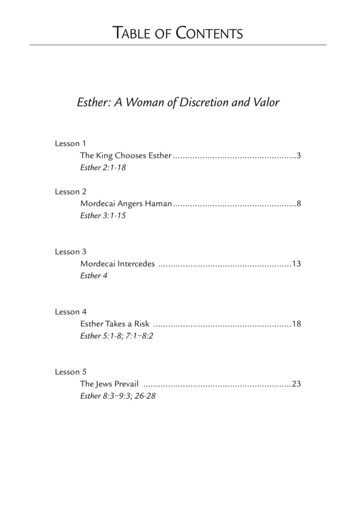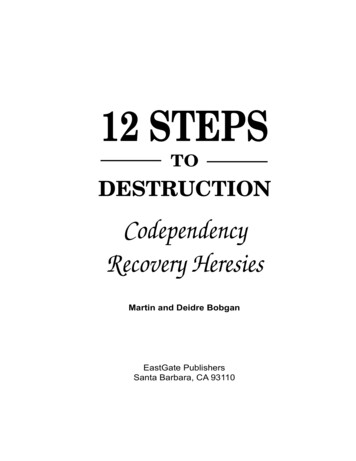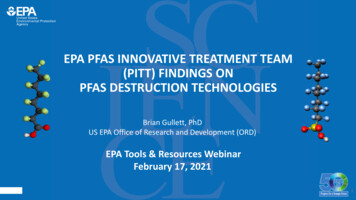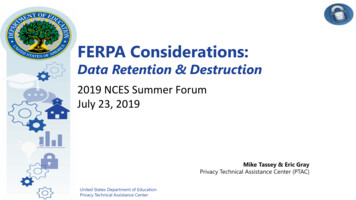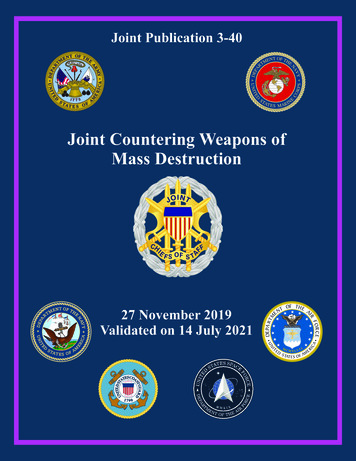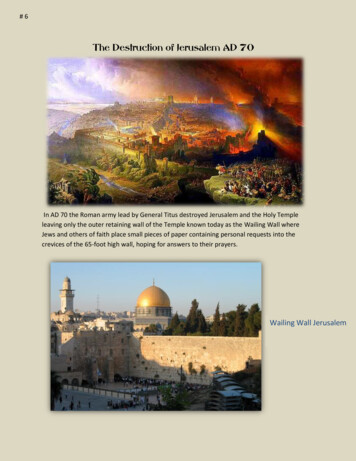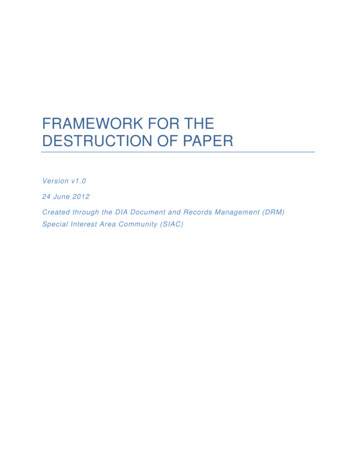
Transcription
FRAMEWORK FOR THEDESTRUCTION OF PAPERVersion v1.024 June 2012Created through the DIA Document and Records Management (DRM)Special Interest Area Community (SIAC)
TABLE OF CONTENTSPosition Statement. 3Overview . 4Process Diagrams . 8Technology Parameters . 11Quality Parameters . 14Records Management Parameters . 20Regulatory Parameters . 28Legal Parameters . 35Last Words: Glossary, Feedback, Next Steps, Acknowledgements . 40Glossary . 42Feedback Mechanism . 552
Position StatementThe Drug Information Association (DIA) supports the efforts of Special Interest AreaCommunities (SIAC) to advance the purposes of the DIA and provide value to the industrywhich it serves. Professionals from within the industry volunteer their time and effort to achieveconsensus on how their business can be improved. Ideas are shared and improvementsdeveloped for implementation within the industry. It is a method of sharing ideas for the benefitof the common good. Within the SIAC for Document and Records Management, an effort wasorganized in 2011 and 2012 to develop the critical requirements for a Framework for theDestruction of Paper.It is the opinion of the professionals within this effort that the reduction of the creation of paper isparamount to the process of better content management. Printing electronic records that thenget scanned into a digital format results in process redundancy and inefficient use of resources.When paper is created or collected, this framework recommends the destruction of that paperfollowing a verified conversion of the document into a digital format, conditional on the following:1) A qualified organizational process is in place and monitored that ensures the digitizedcopy is a complete and accurate representation of the paper version;2) The digitized copy is placed in a validated electronic content management system; and3) A training plan covering the process flow and applicable SOPs has been created, isavailable within the organization, and users have successfully completed the training.These general measures are extended and defined in greater depth within the attachedframework.Creation of this framework was accomplished through the voluntary contributions of the diversespecial interest group professionals who provided their expertise and perspective on what isrequired for paper destruction. Recommendations are derived following extensive discussionsand research in 5 focus areas; namely Technology, Quality, Records Management, Regulatory,and Legal. It is the intention of this framework to break through the recurring obstacles thathave prevented Industry confidence in this area for well over a decade. The scope of this initialeffort is on GCP records created in support of a clinical trial in the International Conference onHarmonization (ICH) regions of North America, Europe, and Japan. The intent of thisframework is not to recommend specific organizational decisions on technology tools or internalprocesses regarding creation of documents.3
OverviewFramework for the Destruction of Paper(for documents scanned and placed in an ECMS)The Drug Information Association (DIA), a recognized and highly respected professionalassociation, and their Special Interest Area Community (SIAC) for Document and RecordsManagement (DRM), has supported an initiative to create a framework for the process andparameters concerning the destruction of paper documentation that has been digitized andplaced in a validated Electronic Content Management System (ECMS). The focus of this initialeffort has been on Good Clinical Practice (GCP) records in the ICH regions of North America,Europe, and Japan. Although perceived to be applicable to other domains of pharmaceuticaland device companies and countries and regions of the world, it has not yet been verified to thisextent.Creation of this framework has involved more than 40 professionals (all DIA members) frommore than 25 pharmaceutical companies, contract research organizations (CROs),consultancies, and technical vendors. Contributors on this group, through the DIA DRM SIAC,have provided their perspective on one or more of the 5 areas of focus within the framework,namely Technology, Quality, Records Management, Regulatory, and Legal. The goal of thisgroup was to create a framework which may be used and adapted by any individual, company,institution, or organization, hereinafter referred to as organization, for their own use. Therefore,the attention of participants was drawn to the non-commercial nature of this forum. This grouphas not been a forum for promotion of products, capabilities, or specific companies.It is acknowledged that the resulting framework will need to be integrated with eachorganization's own policies and practices. The framework is/will continue to be vetted throughmany pharmaceutical companies, contract research organizations (CROs), consultancies, andtechnical vendors, in addition to Regulatory Agencies and other defining bodies who couldeither be contributors or stakeholders who review GCP documentation. Continuing feedback onthe framework is welcomed and encouraged to help it mature and become even more useful.The framework is non-binding in accordance with the DIA’s scope and mission. It should be areference for the industry and should not be considered mandatory, but rather as an opportunityfor harmonization across the industry. The framework does not endorse or require any specifictechnology for implementation.4
Rationale for the Creation of a FrameworkHistorically, paper documents have been created, used, managed, archived and destroyed asdocumentation. Rapidly, the documentation process has changed from creating and managingpaper documents into producing and managing documents in electronic formats. The trend isthat the remaining paper documents are scanned into a digital format and uploaded into anECMS. The process to convert paper to electronic creates redundancy and duplication in themanagement of documentation in support of the business process. The destruction of thescanned paper document is a complicated topic and necessitates a thorough examination of therequirements that confirm the electronic version is a complete and accurate representation ofthe paper that was scanned.The goal of this framework is to provide a single, unified interpretation of the applicable laws,regulations, and industry best practices that apply to a complex, legally defensible, andregulatory compliant paper destruction process for the regions in scope. The framework doesnot provide prescriptive guidance for the detailed processes. This detail will be unique to eachorganization and the decisions owned by the internal stakeholders that use the framework toestablish their own policies and procedures.Organization of the FrameworkThe framework consists of 2 parts: Parameters and Process Diagrams.PARAMETERSWith respect to this framework, the working group considered 5 topic areas. The scope ofversion 1.0 of the framework is limited to assessment in the ICH GCP Guidelines regions ofNorth America, Europe, and Japan. Other regions and countries may be considered in futureversions. The framework considered each of the following topics: TECHNOLOGY: Specific requirements and capabilities of the system QUALITY: Capture process & scan quality RECORDS MANAGEMENT: Policies, procedures, and practices REGULATORY: Established health authority laws & regulations, and GCP, GMP, & GLPstandards LEGAL: Laws of evidence5
Parameters were created for each topic. Each parameter was created following a thoroughassessment of the regulations, laws, guidance, and industry practices currently available. Someother industries that have transitioned to management of electronic content and the eliminationof paper have been used as references. Most parameters include: a statement of interpretationof the statement, and a reference or bibliography of the content used to establish the statement(where available), and if applicable, links to specific process step(s). Parameters have notbeen created for each process step of the process diagrams; however where a parameter isassociated with a process step, it is indicated.PROCESS DIAGRAMSThe included set of process diagrams is for reference only. They are intended to providecontext for the recommendations, and the associated parameters relate to individual processsteps. The set of diagrams are hierarchical, following this order:Overall Processa. Organization Support and Governanceb. Pilot / Proof of Conceptc. Scanning and Destruction of Paper – Scanning Productiond. Scanning and Destruction of Paper – In-Progress Paper Destructione. Scanning and Destruction of Paper – Paper Retention Management6
These diagrams are not intended to provide recommendations for all process steps. Several ofthe steps are color-coded (green) to indicate steps where specific parameters have beencreated, associated with a process step, in this release of the framework.The process diagrams are only a suggestion for a high-level comprehensive process. Eachorganization may decide to follow all process steps, or perhaps limit their effort to several crucialones. It will be their choice. However, to pursue anything less than a careful, comprehensive,quality driven process could yield results that would not support the destruction of scannedpaper.7
Process Diagrams8
9
10
Technology ParametersT1There are minimum requirements for scanner settings to scan and uploaddocuments into an ECMS.INTERPRETATION 300 dots per inch (dpi). This resolution is recommended to ensure that the pagesof the document are legible both on the computer screen and when printed and,at the same time, to minimize the file size. “Paper documents containinghandwritten notes should be scanned at 300 dpi.”Simplex or Duplex for documents that have information on back pagesBi-tonal (Black/White)o If there are attributes to a paper document that are in color, and theseattributes are critical to the interpretation of the content of the document; it isrecommended that the scan of the paper document be in color.PDF/ABIBLIOGRAPHY/REFERENCES1. United States, Food and Drug Administration. FDA Industry Guidance – PortableDocument Format Specifications. 4 Jun. 2008. 17 Sep. 2011. Submissions/UCM163565.pdf 2. United States, Food and Drug Administration. Guidance for Industry - ProvidingRegulatory Submissions in Electronic Format — General Considerations. Oct. 2003.17 Sep. 2011. /Guidances/ucm124751.pdf PROCESS STEPS: 7, 203, 300T2Optical Character Recognition (OCR) technology can be utilized for bothease of content identification and increased search ability within ECMS.INTERPRETATIONWhen an organization decides to convert paper documents to an electronic format anddestroy the paper after the conversion, the organization should consider utilizing OCRtechnology so that the content of electronic documents is searchable. This will add valueto the new format and provide the ability to search for and identify documents with ease.In addition, according to FDA guidance, “If you scan a document to create a PDF file, werecommend that you capture text by optical character recognition (OCR) software sothat the text of the resulting electronic documents is reasonably accessible andsearchable.”BIBLIOGRAPHY/REFERENCES1. United States, Food and Drug Administration. FDA Industry Guidance – PortableDocument Format Specifications. 4 Jun. 2008. 17 Sep. 2011. Submissions/UCM163565.pdf 2. United States. Food and Drug Administration. Guidance for Industry. ProvidingRegulatory Submissions in Electronic or Paper Format to the Office of Food AdditiveSafety. Mar. 2010. 17 Sep. 2011.11
9.pdf PROCESS STEPS: 7, 203, 300T3Change management programs facilitate the successful migration from apaper format to electronic format in ECMS.INTERPRETATIONWhen an organization decides to convert paper content to an electronic format anddestroy the paper content, before, during and after the conversion, the organizationneeds to facilitate the change management and manage the changes appropriately. Partof the change management process could include preparing a value proposition withappropriate communication pieces, establishing change champions and providing propertraining to follow the new processes and to use an appropriate scanner and ECMS.Adopting these other related technologies are critical to the success of migratingdocuments from paper to electronic format.BIBLIOGRAPHY/REFERENCES1. Jones, John, Aquirre, DeAnne, and Calderone, Matthew. “Ten principles of ChangeManagement.” Strategy Business. 15 Apr. 2004. 17 Sep. 2011. ko 643d0 2. “ADKAR Change Management Model.” Change Management Learning Center.1996-2007. 17 Sep. 2011. rview.htm PROCESS STEPS: 6, 106, 107, 202T4There are minimum requirements in electronic document formatting for thepurposes of long term retention and future document reproductioncapabilities.INTERPRETATIONCompanies require assurances that images of the paper documents, which have beenscanned, and the resulting original paper destroyed, are able to be reproduced yearslater. On September 28, 2005 the International Standards Organization (ISO) approveda new Standard governing electronic document archiving; PDF/A as the new archivingstandard. PDF/A is expected to establish itself as the new electronic archiving standard.PDF is prevalent in public and private sectors worldwide and is already an acceptedarchiving format in countless markets. The PDF/A Standard will help ensure that usersget the guarantee of long-term reproducibility.BIBLIOGRAPHY/REFERENCES1. “ISO-19005-1 - Document management - Electronic document file format for longterm preservation - Part 1: Use of PDF 1.4 (PDF/A-1).” 17 Sep. 2011.http://synthis.amcanet.com/ df2. Reeves, Roger and Bärfuss, Hans. “PDF/A – A New Standard for Long-TermArchiving.” PDF Association. 4 Aug. 2011. 17 Sep. 2011. r-long-term-archiving/ PROCESS STEPS: 5, 7, 203, 300, 302, 30412
T5There are core requirements to be followed in addressing the challenges oflong term archiving.INTERPRETATIONWhen using a digital environment, steps must be taken to ensure long-term integrity andaccessibility to electronic documents. The main challenges of long-term digital archivinginclude: 1) authenticity and integrity of data content; 2) viability of information due totechnology obsolescence; and 3) reliable, affordable, sustainable and efficient archivalmedia.BIBLIOGRAPHY/REFERENCES1. Lu, Maohua and Chiueh, Tzi-cker. “Challenges of Long-Term Digital Archiving: ASurvey” Department of Computer Science, Stony Brook University, Stony Brook, NY11794. 17 Sep. 2011. http://www.ecsl.cs.sunysb.edu/tr/rpe19.pdf PROCESS STEPS: 2, 3, 6, 8, 105T6Documents scanned or uploaded must be secured in a validated ECMS.INTERPRETATIONCompanies scanning or uploading documents into an EDMS or ECMS must ensure thatthe system and repository is fully validated in compliance with 21 CFR Part 11 andGAMP5 standards. Refer to Quality Parameters Q1 & Q2 for additional information.BIBLIOGRAPHY/REFERENCES1. United States. Food and Drug Administration. Electronic records; electronicsignatures – Scope and Application, 21 CFR Part 11. Aug. 2013. 17 Sep. ation/Guidances/ucm125125.pdf2. GAMP5. A Risk-Based Approach to Compliant GxP Computerized Systems. ISPE2008.PROCESS STEPS: 7, 106, 107, 20213
Quality ParametersQ1There should be a controlled, quality driven process for documentscanning and uploading into a validated Electronic Content ManagementSystem (ECMS).INTERPRETATIONSteps for consideration:A scanner should be selected that can produce scanned images in a way that meets thetechnology requirements previously identified, including but not limited to scannersettings.The minimum resolution of 300 dpi as identified under the Technology parameters T1 isrecommended to balance legibility with file size. Documents scanned should provideadequate legibility both on a computer screen and printed copy while at the same time,producing a minimal file size.The use of grayscale and color significantly increases the file size and it is onlyrecommended when these features improve the readability of the material. It isrecommended that documents with color also be scanned in color (e.g. color seal, colorcoded data outputs, etc.). After scanning, avoid re-sampling to a lower resolution. Acaptured image should not be subjected to non- uniform scaling (i.e. sizing).Digitized documents should be PDFs. Refer to Technology parameters for versionrecommended. No additional software must be needed to read and navigate the PDFfiles.Preparation Steps for Scanning Documents: Removal of wallets/staples/binding/paperclipsA QC check of original paper documents to determine whether simplex or duplexscanning settings are required. Duplex scanning settings are required if thescanning process will automatically process documents with information on backpages; otherwise double sided documents will have to be manually scanned insimplex setting.There Are 2 Scenarios For Consideration Depending On Scanning Process: Individual document scanningBatch scanningDocuments can be batched for ease of scanning and to facilitate scanning in bulk.If scanning in batches, document separator/cover sheets can be used, to distinguisheach document within the batch. Metadata for indexing should be considered in theprocess.BIBLIOGRAPHY/REFERENCES1. "BIP 0008. Code of Practice on Legal Admissibility and Evidential Weight ofInformation Stored Electronically." British Standards Institution (BSI). http://shop.bsigroup.com/en/ ProductDetail/?pid 000000000030186227 2. United States. Food and Drug Administration. Portable Document Specifications. Submissions/UCM163179.pdf 3. United States. Food and Drug Administration. Guidance for Industry ProvidingRegulatory Submissions in Electronic Format —General toryInformation/Guidances/ucm124751.pdf4. United States. Food and Drug Administration. Guidance for Industry: Computerized14
Systems Used in Clinical Investigations. f 5. Industry opinion and practice though not formally cited in the public domain. Variousdocuments compiled by quality topic team members outlining process and qualitycontrol checks, including scanning settings, pdf version required for scanning (PDF/Ais an ISO Standard for using PDF format for the long-term archiving of electronicdocuments), batch scanning, indexing, QC of scanned documents and importing toan ECMSPROCESS STEPS: 7, 300, 301Q2The authenticity of scanned images as certified copies must beestablished.A QC process should be defined to review the scanned document(s),whether they are bar-coded or routed directly to indexed files.A quality driven process should be established for image quality, indexingquality, and verification of the certified copy. Completion of manual QCprocesses must be documented including a signature to attest foraccuracy and completeness. If completion of QC steps is beingdocumented electronically, then audit trail and/or electronic signaturefunctionality should be implemented as part of the overall validation of theECMS. All QC may be done at individual document level or at a batch level,as per organization process.INTERPRETATIONCriteria For QC: Image Quality (Not In Order of Priority)The following are considerations for companies to assess and to best define their ownorganization-specific requirements for image quality: Are all pages present? Are there any double feeds?Is everything in paper present in the electronic image (i.e. information such asheaders/footers is not cut off? Pages with only header and footer information arenot to be considered as blank pages)?If scanning duplex, does the image contain all of the information?If scanner settings are duplex, are true blank pages removed?Is the document the right size and orientation (e.g., US Letter, A4; landscape)?Are all pages rotated the right way?Is the image too light/too dark?Are pages skewed?Any post it notes inadvertently scanned?o Determination if these notes are to be scanned and added to the electronicdocument as well or replaced onto paper documents that are on Legal Holdis to be determined by the organization.Is all content legible?Are all signatures legible?Are pages in the correct sequence?Are there any bent corners blocking document content?Removal of hole punches on images is not recommended.Removal of any content from the original document is not permitted (e.g. faxheader information).15
De-speckling capabilities were not used.The quality of the image should be a true reproduction of the quality of the original. It isnot recommended that images be enhanced. If an image is too light/dark, retention ofthe paper original should be considered.Criteria For QC: Indexing QualityIndexing document attributes or metadata may be completed prior to or after scanning,depending on organization processes, but all attributes should be checked for accuracybefore QC process is completed and the images are uploaded into an ECM system.Considerations for QC To Create A Certified Copy - Process To Be Defined OrApproved QC process to document the chain of custody and process through the life of theoriginal and electronic document.ooo Tracks how the document came in, who scanned documents and reviewedthe image; capabilities exist to capture scanning parameters.Tracks quantity in terms of number of pages and image quality.Tracks who has uploaded and approved the document.If companies wish to use scanned copies in lieu of the scanned paper anddestroy the original paper, the scanned copies must meet the definition of acertified copy. Organization records management policies must be followed.Any protected documents not to be destroyed should be defined, listed, andmaintained through the life of the trial. (Refer to Glossary for definition of“protected document”)It is recommended that QC steps are performed by a different person than theperson that performed the scanning and indexing.BIBLIOGRAPHY/REFERENCES1. "BS 6498:2002 Guide to preparation of microfilm and other microforms that may berequired as evidence" British Standards Institution (BSI) http://shop.bsigroup.com/en/ProductDetail/ ?pid 000000000019998064 UnitedStates. Food and Drug Administration.2. "BIP 0008. Code of Practice on Legal Admissibility and Evidential Weight ofInformation Stored Electronically." British Standards Institution (BSI). http://shop.bsigroup.com/en/ ProductDetail/?pid 000000000030186227 3. Draft Guidance: Electronic Source Documentation in Clinical Investigations. Dec.2010. nceRegulatoryInformation/Guidances/UCM239052.pdf United States. National Archives and RecordsAdministration (NARA).4. Technical Guidelines for Digitizing Archival Materials for Electronic Access: Creationof Production Master Files – Raster Images. June. 2004. http://www.archives.gov/preservation/ technical/guidelines.pdf Page 435. Industry opinion and practice though not formally cited in the public domainPROCESS STEPS: 302, 303, 30416
Q3There must be a documented quality driven process for destruction ofpaper documents and maintaining certified copies in an ECMS; incompliance with regulations and legal requirements.INTERPRETATIONECM systemsIf companies wish to retain the electronic copies in an ECMS in lieu of paper, the ECMSmust comply with FDA 21 CFR part 11 and Section 5.5 of the Note for Guidance onGood Clinical Practice (CPMP/ICH/GCP/135/95)1. These references include thefollowing additional requirements: Computerized system validationMaintenance of SOPs for the use of the systemMaintenance of an audit trail of data changes ensuring that there is no deletion ofentered data or scanned documentsMaintenance of a security system to protect against unauthorized accessMaintenance of list of the individuals authorized to make data changesMaintenance of adequate backup of the data, safeguard the blinding of the trialand archiving of any source data (i.e. hard copy and electronic). Minimumstandards for back up should be organization specific.Appropriate training records for those involved in the scanning and uploadingprocesses. Documents being easily located and traceable in the systemBIBLIOGRAPHY/REFERENCES1. European Medicines Agency. Q&A: Good Clinical Practice (GCP). Expectations ofEU competent authorities on the use of electronic Trial Master Files.http://www.ema.europa.eu/ema/index.jsp?curl pages/regulation/q and a/q and adetail 000016.jsp&murl menus/regulations/regulations.jsp&mid WC0b01ac05800296c5&jsenabled true2. United States. Food and Drug Administration. FDA Guidance for Industry:Computerized Systems Used in Clinical Investigations Guidance for Industry: Part11; Electronic Records; Electronic Signatures- Scope 0440-gdl0002.pdf3. "BIP 0008. Code of Practice on Legal Admissibility and Evidential Weight ofInformation Stored Electronically." British Standards Institution (BSI). http://shop.bsigroup.com/en/ ProductDetail/?pid 000000000030186227 PROCESS STEPS: 302, 303, 304, 501, 502Q4All training must be completed and documented.INTERPRETATIONAll personnel involved in the scanning, uploading, and QC processes, should haveappropriate training to enable that person to perform the assigned functions. All trainingmust be documented, and training records must be maintained. Competency levelschecked and assessed at the time of training completion, and personnel certificationdocumentation should be maintained.BIBLIOGRAPHY/REFERENCES:1. United States. Food and Drug Administration. Code of Federal Regulations, Title 21,Volume 4. Revised as of April 1, 2011. Sec. 211.25 Personnel qualifications.17
2. European Commission. Commission Guidelines on Good Distribution Practice ofMedicinal Products for Human Use Eudralex, Vol 4, Chapter 2 x/vol-4/20117 gdpguidline publicconsultation.pdfPROCESS STEPS: not applicableQ5Third party requirements must be specified for when activities aretransferred to consultants and vendors.INTERPRETATIONAny duty or function that is transferred to a third party (e.g., CRO, consultants, vendors)must be specified in writing. Third parties must be qualified to provide advice on thesubject for which they are retained. Records must be maintained stating the name,address, and qualifications of any third parties and the type of service they provide. It isrecommended that the standards described in this document are included in vendorcontracts, agreements, oversight plans, etc., as appropriate.BIBLIOGRAPHY/REFERENCES1. Guideline for Good Clinical Practice E6. ICH Harmonized Tripartite. Section 5.2,Contract Research Organization2. United States. Food and Drug Administration. Code of Federal Regulations, Title 21,Volume 4. Revised as of April 1, 2011. Sec. 211.34 Consultants.PROCESS STEPS: 104,107Q6Monitoring of quality must take place.INTERPRETATIONIt is recommended that continuous review or conduct of routine monitoring and/or auditsof systems occur to ensure validation processes and specified requirements are beingmet and maintained.BIBLIOGRAPHY/REFERENCES1. United States. Food and Drug Administration. Code of Federal Regulations, Title 21,Volume 4. Revised as of April 1, 2011. Sec. 21 CFR 820.22 Quality Systems.2. United States. Food and Drug Administration. Code of Federal Regulations, Title 21,Volume 4. Revised as of April 1, 2011. Sec. 21 CFR 820.75b Process Validation.PROCESS STEP: 106, 108Q7It is critical to perform a risk assessmentINTERPRETATIONA risk management and mitigation plan should be established in a Paper Destructionpilot process. Milestones and considerations throughout the pilot, as well as at the end of thepilot to determine how to proceed with a paper destruction process arerecommended.This risk management and mitigation plan must align with organization’s riskmanagement policies.18
BIBLIOGRAPHY/REFERENCES1. "ISO 31000:2009. Risk Management- Principles and Guidelines." InternationalOrganisation for Standardizationhttp://www.iso.org/iso/catalogue detail?csnumber 431702. Industry opinion and practice though not formally cited in the public domainPROCESS STEPS: 106, 201Q8The paper destruction process and certification of destructionrequirements nee
steps. The set of diagrams are hierarchical, following this order: Overall Process a. Organization Support and Governance b. Pilot / Proof of Concept c. Scanning and Destruction of Paper – Scanning Production d. Scanning and Destruction of Paper – In-Progress Paper Destruction e. Scanning and D




